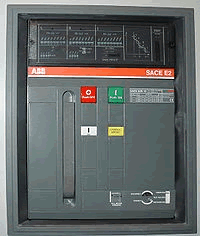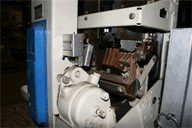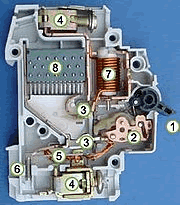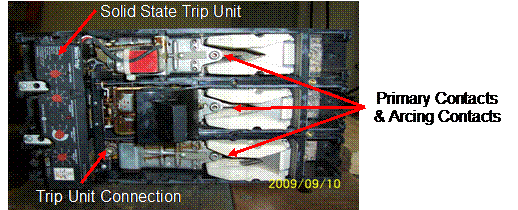![]()
Warren C. Garber
NETA Test Technician,
Infraspection Level III Thermographer
Industrial Electric Testing, Inc.
11321 West Distribution AvenueJacksonville, FL 32256Ph: 904-260-8378www.industrialelectrictesting.com
Abstract
As thermographers, we see many thermal anomalies in switchgear and panelboards. However, finding the actual root cause of what appears to be high contact resistance is not as straightforward as you may think. Circuit breakers have many internal mechanical connections, all of which can radiate heat under load.
Misdiagnosing thermal anomalies can result in added time, wasted money and unnecessary damage to critical equipment. Additionally, there is the frustration involved with finding that same problem during the follow-up inspection, and then having to explain to the customer or your boss why the money that was spent to tighten the “connection problem” didn’t rectify the problem.
In this presentation I will discuss the parts of circuit breakers and the ways that those parts can cause thermal anomalies commonly called “connection problems”. I will show, using a primary injection test set, how different connections within the breakers will produce thermal anomalies and I will then demonstrate a voltage drop technique to determine the location of the abnormal resistance.
Discussion
Low Voltage Circuit Breakers
Low voltage (less than 600 VAC) circuit breaker types common in domestic, commercial and industrial applications include:
- Molded Case Circuit Breaker – rated current up to 1000A. Are generally used for low-current, low-energy power circuits. Molded case circuit breakers have self-contained overcurrent trip
 elements. Conventional thermal magnetic circuit breakers employ a thermal bimetallic element that has inverse time-current characteristics for overload protection and a magnetic trip element for short-circuit protection. Many manufacturers are now switching over from bimetallic elements to power sensor (solid state) type trip elements. Magnetic trip only breakers have no thermal element. These breakers are principally used only for short circuit protection. Nonautomatic circuit breakers have no overload or short-circuit protection. They are primarily used for manual switching.
elements. Conventional thermal magnetic circuit breakers employ a thermal bimetallic element that has inverse time-current characteristics for overload protection and a magnetic trip element for short-circuit protection. Many manufacturers are now switching over from bimetallic elements to power sensor (solid state) type trip elements. Magnetic trip only breakers have no thermal element. These breakers are principally used only for short circuit protection. Nonautomatic circuit breakers have no overload or short-circuit protection. They are primarily used for manual switching.
- Insulated-Case Circuit Breakers – rated current up to 5000A with interrupting capacities
 through 200ka. Insulated case circuit breakers are molded case circuit breakers using glass-reinforced insulating materials for increased dielectric strength. They have push to open buttons with rotary operated low torque handles with independent spring charged mechanisms. This type of mechanism provides for quick-make and quick-break protection. Wide choices of automatic trip units are available for these breakers.
through 200ka. Insulated case circuit breakers are molded case circuit breakers using glass-reinforced insulating materials for increased dielectric strength. They have push to open buttons with rotary operated low torque handles with independent spring charged mechanisms. This type of mechanism provides for quick-make and quick-break protection. Wide choices of automatic trip units are available for these breakers.
- Heavy-Duty Power Circuit Breakers – rated current from 400 to 5000A with interrupting capacities of up to 85ka.
 Heavy-duty power circuit breakers employ spring operated, stored energy mechanisms for quick-make and quick-break manual or electric operation. Generally, these breakers have draw-out features whereby individual breakers can be de-energized for maintenance purposes. The manually stored energy breakers are charged and closed by use of an operating handle. The electrically operated breakers are operated by a motor or a solenoid.
Heavy-duty power circuit breakers employ spring operated, stored energy mechanisms for quick-make and quick-break manual or electric operation. Generally, these breakers have draw-out features whereby individual breakers can be de-energized for maintenance purposes. The manually stored energy breakers are charged and closed by use of an operating handle. The electrically operated breakers are operated by a motor or a solenoid.
Overcurrent Protective Devices
The low voltage protective devices are direct-acting trip, and static trip.
- Direct-acting Trip Devices – use a solenoid (electromagnet) whose pulling force increases with the current. The circuit breaker contacts are held closed by a latch. As the current in the solenoid increases beyond the rating of the circuit breaker, the solenoid’s pull releases the latch which then allows the contacts to open by spring action. Ambient temperature affects the time delay but does not affect the current rating of a magnetic breaker. Thermal magnetic circuit breakers, which are the type found in most distribution boards, incorporate both techniques with the electromagnet responding instantaneously to large surges in current (short circuits) and the bimetallic strip responding to less extreme but longer-term over-current conditions.
Direct-acting trips on insulated-case and heavy-duty power circuit breakers are of the electromagnetic type. Four trip devices are available: (1) Long Time Delay (LT), (2) Short Time Delay (ST), (3) Instantaneous (INST) and (4) Ground Fault (GF). Any combination of the four functions are available to provide protection for overcurrents. A trip device is installed on each phase of the electrical circuit. The LTD, STD, INST, and GF trip devices are available in adjustable time bands to facilitate the coordination of various trip devices in series. All these units have adjustable settings.
- Static-Trip Devices – Static-trip devices are completely static; that is, there are no moving parts. These devices use semiconductor-based integrated circuits, capacitors, transformers, and other electronic components. Static-trip devices operate to open the circuit breaker when the current time relationship exceeds a preselected value. The energy required to trip the breaker is obtained from the circuit being protected. No external power, such as DC batteries, is required. The complete static-trip system is comprised of:
1. Primary circuit current transformers, sensors are a toroidal type mounted one per phase on the primary studs of the circuit breaker. These transformers provide a signal to the static trip device proportional to the primary current.
2. Static logic box, receives the signal from the primary current transformers. It monitors the signal, senses overloads or faults, and executes the required action in accordance with preselected settings.
3. Tripping actuator, a magnetically held latch device that receives the output signal from the static logic box, and in turn causes the circuit breaker to open.
The power supply for the static logic boxes and the tripping actuator is supplied from a separate set of sensors mounted in the breaker studs. In addition to the phase overcurrent logic boxes, a ground fault sensing feature may be provided. New design advances are continually being made in the development of static-trip devices.
Electrical Resistance
The electrical resistance of an object is a measure of its opposition to the passage of a steady electric current. An object of uniform cross section will have a resistance proportional to its length and inversely proportional to its cross-sectional area, and proportional to the resistivity of the material. Discovered by Georg Ohm in the late 1820s, electrical resistance shares some conceptual parallels with the mechanical notion of friction. The measurement unit of electrical resistance is the ohm, symbol Ω. The resistance of an object determines the amount of current through the object for a given potential difference across the object, in accordance with Ohm’s law:

- R is the resistance of the object, measured in ohms
- V is the potential difference across the object, measured in volts
- I is the current through the object, measured in amperes
The resistance of an object can be defined as the ratio of voltage to current:

Resistivity, and therefore Resistance, is temperature dependent. For most materials as the temperature increases the resistance also increases. As the resistance increases due to temperature the ratio of voltage-to-current will also rise, often resulting in a drop of utilization voltage and current.
Parts of the Circuit Breaker
The internal parts of a circuit breaker consist of many contact points and mechanical connections all of which can generate heat under load. The picture below shows a cutaway of a single pole 20 amp circuit breaker.
1. Actuator lever – used to manually trip and reset the circuit breaker. Also indicates  the status of the circuit breaker (On or Off/tripped). Most breakers are designed so they can still trip even if the lever is held or locked in the “on” position. This is sometimes referred to as “free trip” or “positive trip” operation.
the status of the circuit breaker (On or Off/tripped). Most breakers are designed so they can still trip even if the lever is held or locked in the “on” position. This is sometimes referred to as “free trip” or “positive trip” operation.
2. Actuator mechanism – forces the contacts together or apart.
3. Contacts – Allows current when touching and breaks the current when moved apart.
4. Terminals
5. Bimetallic strip
6. Calibration screw – allows the manufacturer to precisely adjust the trip current of the device after assembly.
7. Solenoid
8. Arc divider / extinguisher
As you can see, there is a lot more to a circuit breaker than just a line and a load side conductor connection. Poor contact on any one of these internal connections can cause heating within the breaker. The problem is there is enough thermal mass in the breaker body to hide the true cause of the heat. Think of the internal parts of the circuit breaker as a fused disconnect that you can only see the line and load side connections of. Many of the same parts are there, contacts and mechanical connections, with the addition of the removable trip unit on some styles of breakers.

Above is a molded case circuit breaker with a solid state trip unit installed.
The breaker cover has been removed to show the internal parts
Locating and Confirming these Internal Problems
It is very important to note that electricity is very dangerous. Only qualified technicians should conduct these types of inspections. This test requires that a volt meter be used to determine the voltage drop on live electrical circuits. When conducting an electrical infrared inspection all covers and dead fronts must first be removed by a qualified person.
Breaker internal problems appear thermally to be connection problems and sometimes even look as if to be load imbalance issues. These anomalies in most cases do not have very large temperature rises and can be easily overlooked. Because the heat found in these situations is indirect, the result of a much higher temperature within the breaker that can not be seen directly, normal recommendations based on temperature rise should not be used. Thermography can be used to locate these problems but additional testing is needed to determine the severity and the cause of the heat.
Because the breakers may be stacked in the panel or switchgear it may be difficult to get line of sight to the side of the breaker, where the breaker body material is thinnest, to see a temperature rise on the breaker body. The heat is sometimes also located in the space between two breakers. While conducting the inspection, it is important to move around because the heat may be seen reflecting off the back of the panel or bus behind the breaker.

The thermal images above show the results of a breaker with internal heating.
The heating cannot be seen on the breaker body but as a reflection on the back of the panel.
When these types of thermal anomalies are located it is important to know the load of all phases of the breaker. If the load is balanced then a simple Milli-volt drop test can be conducted. A Milli-volt drop test can disclose several abnormal conditions inside a breaker such as eroded contacts, contaminated contacts, or loose internal connections. This test is conducted while the circuit is energized and under load. One lead of a volt meter is placed on the load side with the other on the line side of the breaker. The reading is the voltage drop through the breaker internal connections. These readings can then be compared to one another to determine if the problem is internal to the breaker. If the load is not balanced, the voltage drop readings are collected using a volt meter. Then Ohm’s law can be used to calculate the resistance of each phase. After the calculated resistance is found for each phase the values can then be compared to each other to determine if the problem is internal to the breaker.
Conclusion
While conducting an infrared inspection of an electrical system it is important to think outside the box. A building electrical system consists of many integral parts that all must operate together to be a safe and efficient system. Thermography is an important tool in finding problems within the system; however, there must be other tools in the box. If, during an inspection, problems with the circuit breakers are found it should be noted correctly in the written report with all needed information and the customer notified. Then, a qualified electrical testing company can perform electrical tests on these circuit breakers to determine the proper corrective action.
References
1. Robert Friedel and Paul Israel, “Edison’s Electric Light: Biography of an Invention”, Rutgers University Press, New Brunswick, New Jersey USA, 1986 ISBN 0-8135-1118-6 pp. 65-66
2. B. M. Weedy, “Electric Power Systems Second Edition”, John Wiley and Sons, London, 1972, ISBN 0471924458 pp. 428-430
3. http://bonle.en.alibaba.com/product/50348671/51680889/Switch/MCB_MCCB.html
4. http://www3.interscience.wiley.com/journal/113307491/abstract?CRETRY=1& SRETRY=0 Electrical Engineering in Japan, vol. 157 issue 4 pp. 13-23
5. United States Department of the Interior Bureau of Reclamation. Denver, Colorado, Facilities Instructions, Standards and Techniques, Volume 3-16, Maintenance of Power Circuit Breakers, Internet Version of this Manual Created December 1999, Hydroelectric Research and Technical Services Group



